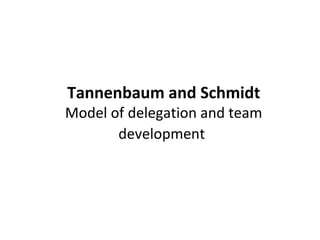
Tannenbaum and schmidt
- 1. Tannenbaum and Schmidt Model of delegation and team development
- 2. • Simple model which shows relationship between the level of freedom given and the level of authority used by the manager. • As the team's freedom is increased, so the manager's authority decreases. • The principle of being able to apply different levels of delegated freedom closely relates to the 'levels of delegation‘. • The manager should delegate and ask a team to make its own decisions • A rising scale of levels of delegated freedom can be used.
- 3. The Tannenbaum and Schmidt Graph
- 4. Levels of Delegated Freedom
- 5. 1) The Manager decides and announces the decision. • The manager: - reviews options in light of aims, issues, priorities, timescale, etc. - decides the action and informs the team of the decision. - will probably have considered how the team will react, but the team plays no active part in making the decision. • The team may well perceive that the manager has not considered the team's welfare at all. The team sees this as a purely task-based decision, which is generally a characteristic of X-Theory management style.
- 6. 2) The manager decides and then 'sells' the decision to the group. • The manager: - makes the decision as in 1 - explains reasons for the decision to the team, particularly the positive benefits that the team will enjoy from the decision. • In so doing the manager is seen by the team to recognise the team's importance, and to have some concern for the team.
- 7. 3) The manager presents the decision with background ideas and invites questions. • The manager presents the decision along with some of the background which led to the decision. • The team is invited to ask questions and discuss with the manager the rationale behind the decision, which enables the team to understand and accept or agree with the decision more easily than in 1 and 2. • This enables the team to appreciate the issues and reasons for the decision, and the implications of all the options. • This will have a more motivational approach than 1 or 2 because of the higher level of team involvement and discussion.
- 8. 4. The manager suggests a provisional decision and invites discussion about it. • The manager discusses and reviews the provisional decision with the team on the basis that the manager will take on board the views and then finally decide. • This enables the team to have some real influence over the shape of the manager's final decision, and also acknowledges that the team has something to contribute to the decision-making process, which is more involving and therefore motivating than the previous level.
- 9. 5) The manager presents the situation or problem, gets suggestions, then decides. • The manager presents the situation, and maybe some options, to the team. • The team is encouraged and expected to offer ideas and additional options, and discuss implications of each possible course of action. • The manager then decides which option to take. • This level is one of high and specific involvement for the team, and is appropriate particularly when the team has more detailed knowledge or experience of the issues than the manager. • Being high-involvement and high-influence for the team this level provides more motivation and freedom than any previous level.
- 10. 6) The manager explains the situation, defines the parameters and asks the team to decide. • The manager has effectively delegated responsibility for the decision to the team, albeit within the manager's stated limits. • The manager may or may not choose to be a part of the team which decides. • While this level appears to gives a huge responsibility to the team, the manager can control the risk and outcomes to an extent, according to the constraints that he stipulates. • This level is more motivational than any previous, and requires a mature team for any serious situation or problem.
- 11. 7) The manager allows the team to identify the problem, develop the options, and decide on the action, within the manager's received limits. • Extreme level of freedom, whereby the team is effectively doing what the manager did in level 1. • The team is given responsibility for: - identifying and analysing the situation or problem - the process for resolving it - developing and assessing options; evaluating implications - deciding on and implementing a course of action. • The manager: - states that he/she will support the decision and help the team implement it. - may or may not be part of the team, and if so then he/she has no more authority than anyone else in the team. • The only constraints and parameters for the team are the ones that the manager had imposed on him from above • This level is potentially the most motivational of all, but also potentially the most disastrous. Not surprisingly the team must be mature and competent, and capable of acting at what is a genuinely strategic decision-making level.
- 12. Conclusion • Over time, a manager should aim to : - take the team from one end to the other, up the scale, - have developed one or a number of potential successors from within his team to take over from him, and - has to explain what he’s doing, and be aware constantly of how your team is responding and developing. • When examining and applying the Tannenbaum and Schmidt principles, it's extremely important to remember: - Irrespective of the amount of responsibility and freedom delegated by a manager to a team - The manager retains accountability for any catastrophic problems that result.. If everything goes well, the team must get the credit; if it all goes horribly wrong, the manager must take the blame.
